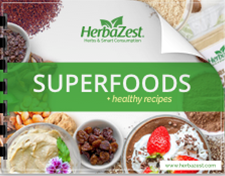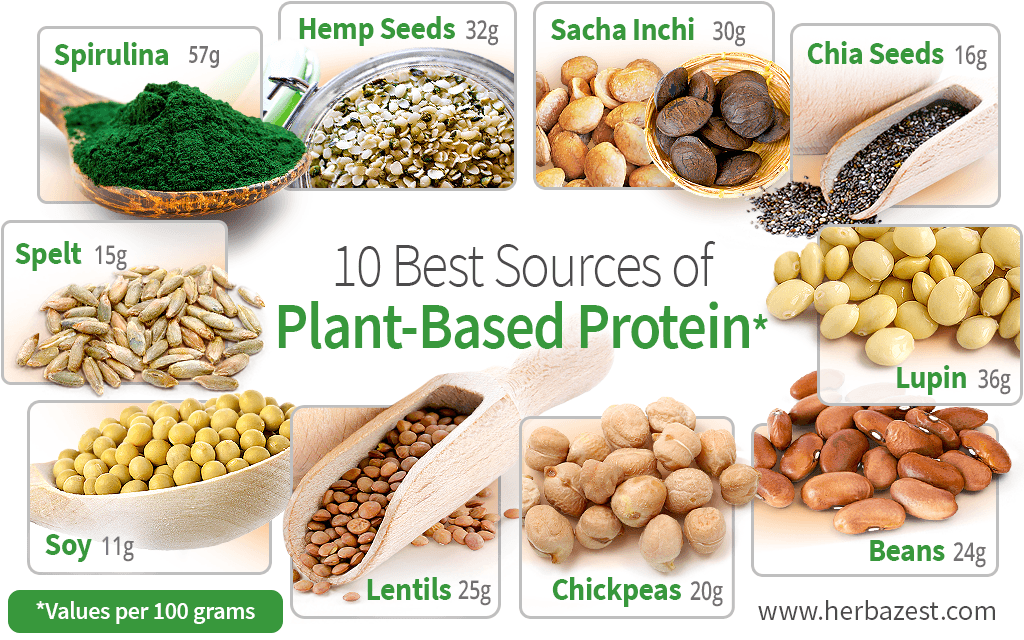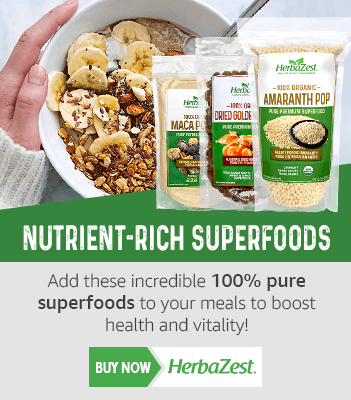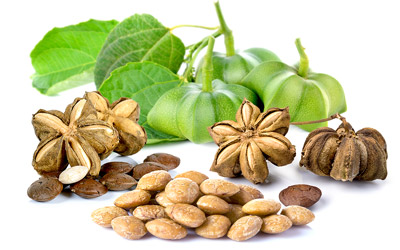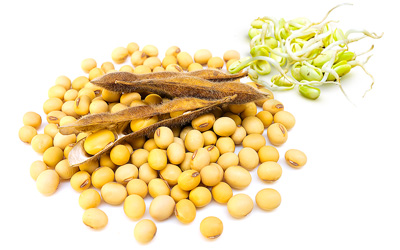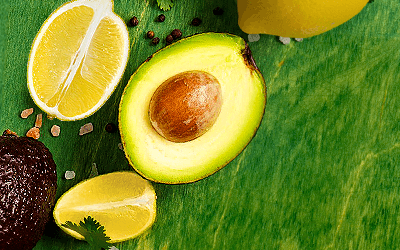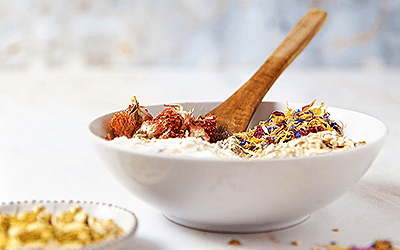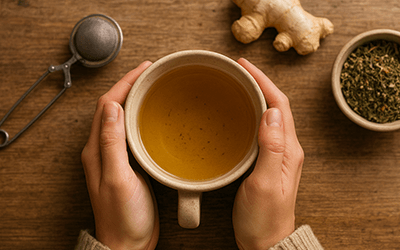Whether for health, ethical, or other personal reasons, more and more people are shifting their attention to vegetable protein. Some eat it as part of a vegan diet, while others substitute it for meat a couple of times per week. Either way, having a handy cheat sheet with the best meatless protein options can help you save time and ensure your meals are balanced and packed with nutrients. Discover 10 best sources of plant-based protein and see how they can enrich your daily meals.
1. Spirulina
Spirulina opens our list of the best sources of plant-based protein. This blue-green algae is known to contain powerful antioxidants, but many people don't associate it with protein, and wrongly so. It packs an astounding 57 grams of protein per 100 grams—and not just any protein.1 Spirulina is a complete protein, meaning it contains all nine essential amino acids that our bodies need to obtain from food. No wonder why it's such a popular supplement!
2. Lupin
Depending on where you live, lupin may not be as familiar to you as the other foods on this list. But it's worth looking into. This legume is closely related to peanuts, and it's loaded with essential amino acids, offering 36 grams of protein per 100 grams.2 They're also rich in fiber, vitamins, and minerals. While lupin beans may be hard to find locally, lupin flour—which is naturally gluten-free—is becoming more popular online.
3. Hemp Seeds
Rich sources of vegetable protein also include hemp seeds, known as hemp hearts as well. Just like spirulina, these small seeds are a complete protein. They offer 32 grams of protein per 10 grams of hulled seeds, including high levels of the amino acid, arginine.3 On top of that, hemp seeds are incredible sources of healthy fats as well as dietary fiber and minerals, like phosphorus, potassium, and magnesium.
4. Sacha Inchi Seeds
Valued by the indigenous South American societies for centuries, sacha inchi seeds are powerhouses of key nutrients. They offer 30 grams of complete protein per 100 grams, alongside high amounts of healthy fats and fiber.4 Interestingly, sacha inchi is rich in tryptophan, an essential amino acid that plays a key role in mood, behavior, and cognition. Sacha inchi seeds are also known under other names, like Inca or mountain peanut.
5. Lentils
Adored in stews, curries, burgers, and even brownies, lentils are one of the most nutritious foods out there, which also includes high protein content. A ½ cup serving (about 100 grams) of raw lentils offers 25 grams of complete protein.5 As an added bonus, these legumes are also excellent sources of fiber, B vitamins, iron, magnesium, and potassium.
6. Beans
If you want to keep your meals varied and nutritious, you can never go wrong with beans. With several hundred types of beans out there, you won't taste boredom in your kitchen ever again. Depending on its type, beans generally pack about 24 g of protein per 100 g.6 Plus, they'll enrich your body with dietary fiber, folate, iron, potassium, magnesium, and other minerals.
7. Chickpeas
Chickpeas is another staple plant-based protein source in many kitchens. Thanks to its neutral flavor and versatility, it's a frequent ingredient in a variety of savory and sweet dishes. But it is chickpeas' nutritional content that deserves all the attention. With complete protein (20 g per 100 g), complex carbs, B vitamins, and key minerals, chickpeas is a healthful option for vegans and meat eaters alike.7
8. Chia Seeds
With 16 grams of complete protein per 100 grams as well as fiber and healthy fats, chia seeds are a great source of plant protein.8 On top of that, they contain dietary fiber (both soluble and insoluble) and healthy fats (that is, omega-3 fatty acids). Scientific research has revealed numerous benefits of these tiny seeds, including that chia seeds may induce satiety and reduce hunger.
9. Spelt
Spelt is yet another protein-packed plant option for you. This ancient cereal with European roots packs 15 grams of protein per 100 grams.9 Cooked whole grains can be used to replace rice, quinoa, or buckwheat. Spelt flour, on the other hand, is a nutritious option for breads, pancakes, and baked goods. Being a hybrid of two wheat species, spelt contains gluten. So, it's best to avoid it in case of dietary restrictions.
10. Soy
Soy is one of the most popular sources of complete vegetable proteins. The exact protein content depends on the soy product consumed. For example, about 100 grams of cooked edamame (immature soybeans) contain 11 g of protein.10 Soy is also rich in phytoestrogens, which are known to benefit female health. On a downside, soy is also one of the most common allergens and is often genetically modified.
It is worth keeping in mind that cooking can reduce foods' nutritional content to a certain extent. However, regardless of the cooking method you use, these 10 plant-based protein sources can still enrich your meals with protein and other key nutrients. On top of that, they will support muscle growth, boost energy, and increase satiety, keeping you happy and full for longer.
Sources
- Annual Review of Food Science and Technology, Plant-Based Proteins: The Good, Bad, and Ugly, 2022
- Eufic, Plant-based protein: all you need to know to get enough of it
- NutritionFacts.org, Plant Protein
- American Heart Association, Plant-Based Sources of Protein Infographic, 2022
Footnotes:
- USDA. (2019). Seaweed, spirulina, dried. Retrieved November 24, 2022, from https://fdc.nal.usda.gov/fdc-app.html#/food-details/170495/nutrients
- USDA. (2019). Lupin, mature seeds, raw. Retrieved November 24, 2022, from https://fdc.nal.usda.gov/fdc-app.html#/food-details/172423/nutrients
- USDA. (2019). Seeds, hemp seed, hulled. Retrieved November 24, 2022, from https://fdc.nal.usda.gov/fdc-app.html#/food-details/170148/nutrients
- Nutrition Value. (n.d.). Sacha inchi seeds by organic traditions. Retrieved November 24, 2022, from https://www.nutritionvalue.org/Sacha_inchi_seeds_by_ORGANIC_TRADITIONS_481353_nutritional_value.html?size=100+g
- USDA. (2019). Lentils, raw. Retrieved November 24, 2022, from https://fdc.nal.usda.gov/fdc-app.html#/food-details/172420/nutrients
- USDA. (2019). Beans, kidney, all types, mature seeds, raw. Retrieved November 24, 2022, from https://fdc.nal.usda.gov/fdc-app.html#/food-details/175193/nutrients
- USDA. (2019). Chickpeas (garbanzo beans, Bengal gram), mature seeds, raw. Retrieved November 24, 2022, from https://fdc.nal.usda.gov/fdc-app.html#/food-details/173756/nutrients
- USDA. (2019). Seeds, chia seeds, dried. Retrieved November 24, 2022, from https://fdc.nal.usda.gov/fdc-app.html#/food-details/170554/nutrients
- USDA. (2019). Spelt, uncooked. Retrieved November 24, 2022, from https://fdc.nal.usda.gov/fdc-app.html#/food-details/169745/nutrients
- USDA. (2022). Edamame, cooked. Retrieved November 24, 2022, from https://fdc.nal.usda.gov/fdc-app.html#/food-details/2342911/nutrients
